Research Briefs
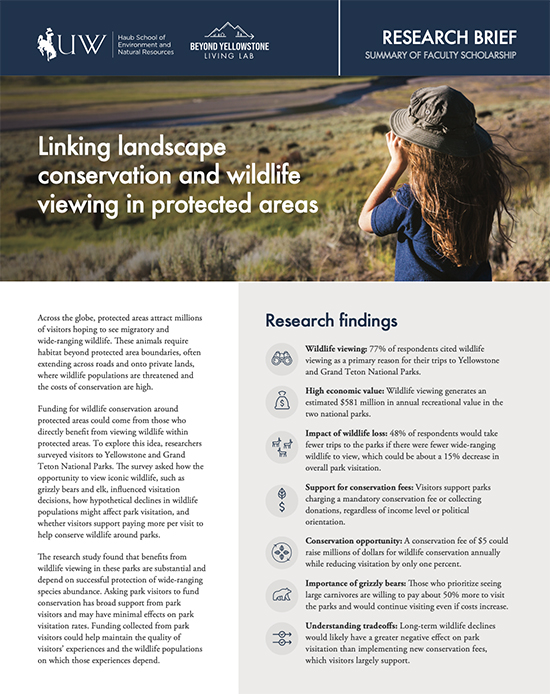 |
Linking landscape
|
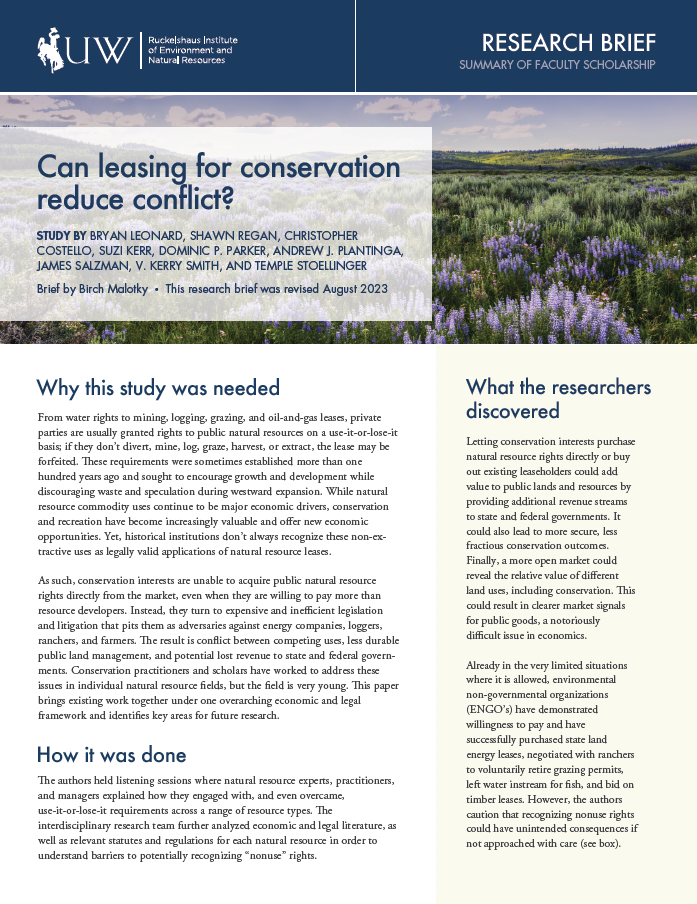 |
Can Leasing For Conservation Reduce Conflict?Report by Bryan Leonard, Shawn Regan, Christopher Costello, Suzi Kerr, Dominic P. Parker, Andrew J. Plantinga, James Salzman, V. Kerry Smith, and Temple Stoellinger From water rights to mining, logging, grazing, and oil-and-gas leases, private parties are usually granted rights to public natural resources on a use-it-or-lose-it basis; if they don’t divert, mine, log, graze, harvest, or extract, the lease may be forfeited. As such, conservation interests are unable to acquire public natural resource rights directly from the market, even when they are willing to pay more than resource developers. The authors of this study held listening sessions, analyzed economic and legal literature, and looked at relevant statutes and regulations to understand what would be involved—and what potential side effects might be—if "non-use" rights were recognized. They found that letting conservation interests purchase natural resource rights could provide a market-based alternative to top-down regulation when navigating multiple uses on public land. The authors also outlined a series of potential pitfalls and called for further research. |
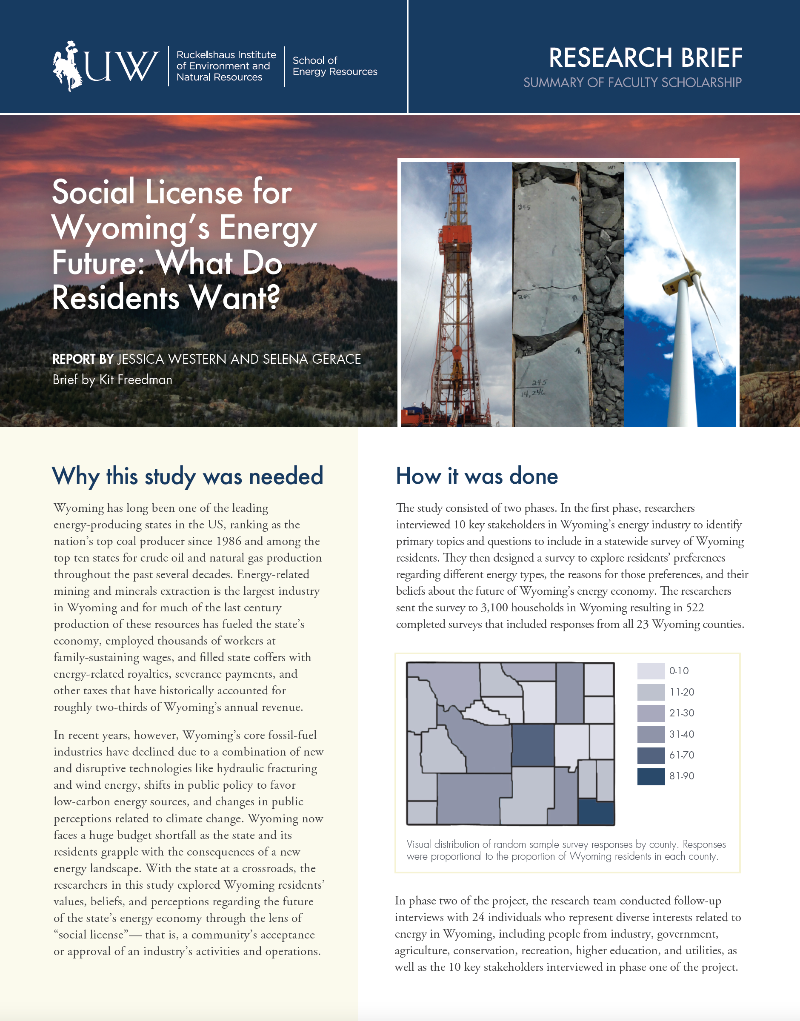 |
Social License for Wyoming's Energy Future: What Do Residents Want?Report by Jessica Western and Selena Gerace This two-year study was a collaboration between the University of Wyoming's School of Energy Resources and Ruckelshaus Institute to explore Wyoming residents' perceptions about the state's energy future. The research describes Wyoming citizens' vision for an energy future that is all-inclusive, innovative, and forward-looking, and which considers external market demands and climate change as well as ensures access to reliable low-cost energy, provides a safety net for energy workers, and protects wildlife. |
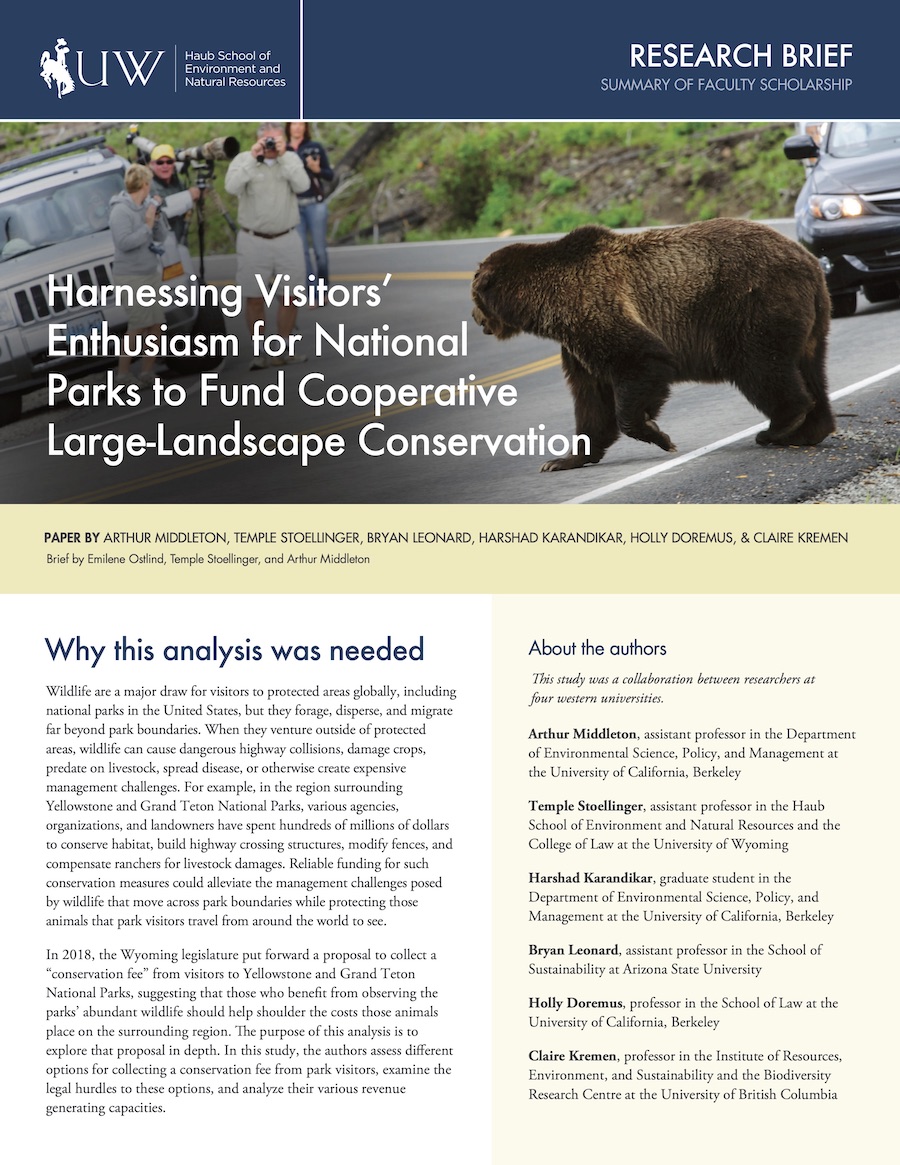 |
Harnessing Visitors' Enthusiasm for National Parks to Fund Cooperative Large-Landscape ConservationPaper by Arthur Middleton, Temple Stoellinger, Harshad Karandikar, Bryan Leonard, Holly Doremus, and Claire Kremen In 2018, the Wyoming legislature put forward a proposal to collect a “conservation fee” from visitors to Yellowstone and Grand Teton National Parks, suggesting that those who benefit from observing the parks’ abundant wildlife should help shoulder the costs those animals place on the surrounding region. In this study, the authors explore that proposal by assessing different options for collecting a conservation fee from park visitors, examining the legal hurdles to these options, and analyzing their various revenue generating capacities. Explore the interactive version |
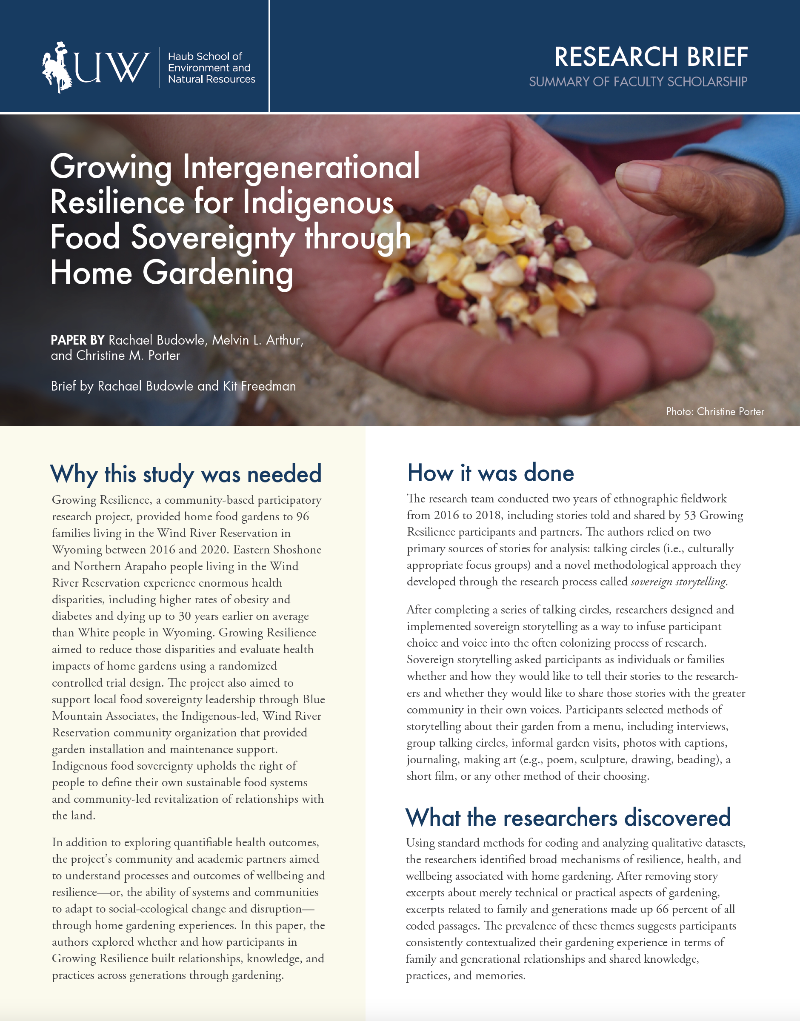 |
Growing Intergenerational Resilience for Indigenous Food Sovereignty through Home GardeningPaper by Rachael Budowle, Melvin Arthur, and Christine Porter Growing Resilience, a community-based participatory research project designed to promote health and wellbeing, provided installation and maintenance support for home food gardens to 96 primarily Eastern Shoshone and Northern Arapaho families living in the Wind River Reservation in Wyoming. The authors of this study investigated how participants’ stories about gardens are rooted in family relationships, knowledge, and practices through time. In present, past, future, and cross-generational frames, families transmitted resilience through gardening across generations. Explore the interactive version |
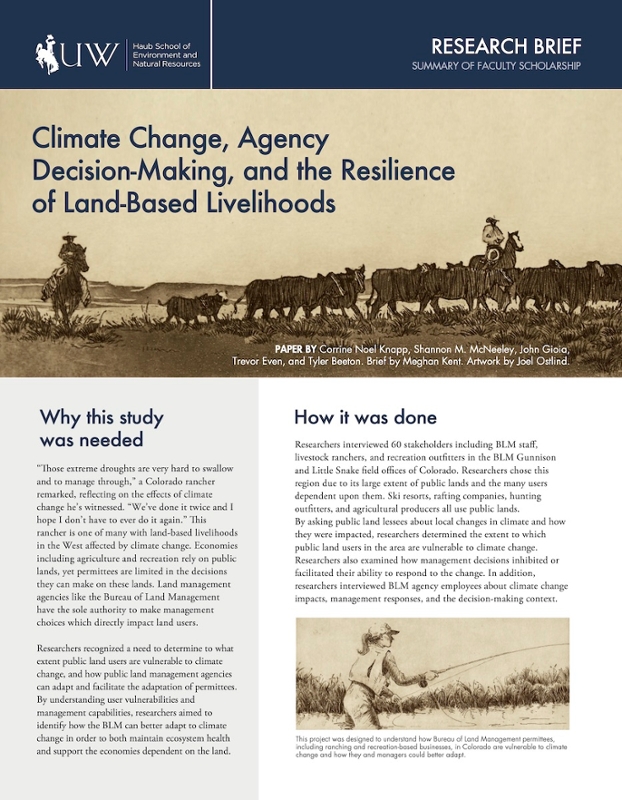 |
Climate Change, Agency Decision-Making, and the Resilience of Land-Based LivelihoodsPaper by Corrine Noel Knapp, Shannon M. McNeely, John Gioia, Trevor Even, and Tyler Beeton Economies including agriculture and recreation rely on public lands, yet permittees are limited in the decisions they can make on these lands. Land management agencies like the Bureau of Land Management have the sole authority to make management choices which directly impact land users. Researchers recognized a need to determine to what extent public land users are vulnerable to climate change, and how public land management agencies can adapt and facilitate the adaptation of permittees. |
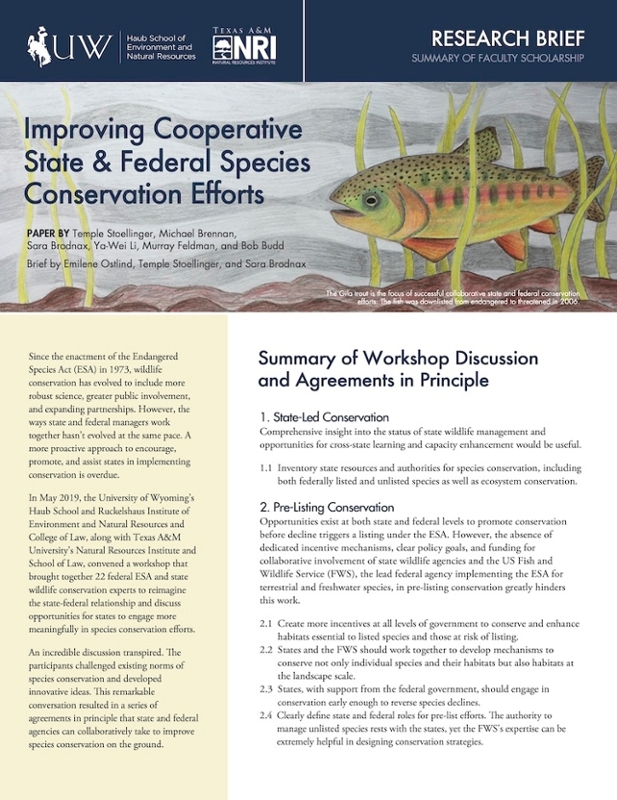 |
Improving Cooperative State & Federal Species Conservation EffortsPaper by Temple Stoellinger, Michael Brennan, Sara Brodnax, Ya-Wei (Jake) Li, Murray Feldman, and Bob Budd In May 2019, the University of Wyoming’s Haub School and Ruckelshaus Institute of Environment and Natural Resources and College of Law, along with Texas A&M University’s Natural Resources Institute and School of Law, convened a workshop that brought together 22 federal ESA and state wildlife conservation experts to reimagine the state-federal relationship and discuss opportunities for states to engage more meaningfully in species conservation efforts. This remarkable conversation resulted in a series of agreements in principle that state and federal agencies can collaboratively take to improve species conservation on the ground. Explore the interactive version |
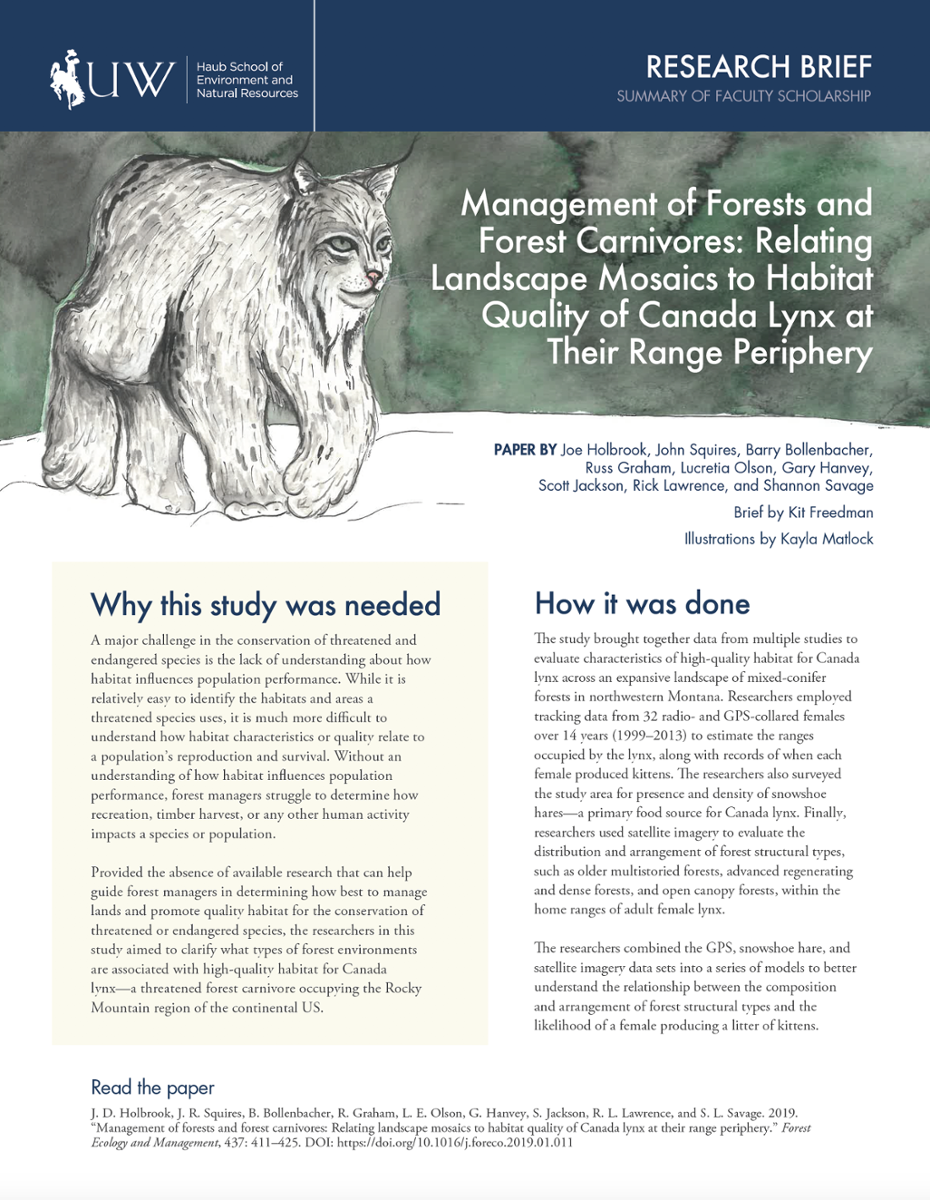 |
Management of Forests and Forest Carnivores: Relating Landscape Mosaics to Habitat Quality of Canada Lynx at Their Range PeripheryPaper by Joe Holbrook, John Squires, Barry Bollenbacher, Russ Graham, Lucretia Olson, Gary Hanvey, Scott Jackson, Rick Lawrence, and Shannon Savage This study brought together data from multiple studies to evaluate characteristics of high-quality habitat for Canada lynx to assist forest managers in identifying habitat attributes that contribute to the reproductive success of female Canada lynx, a federally threatened species. Explore the interactive version |
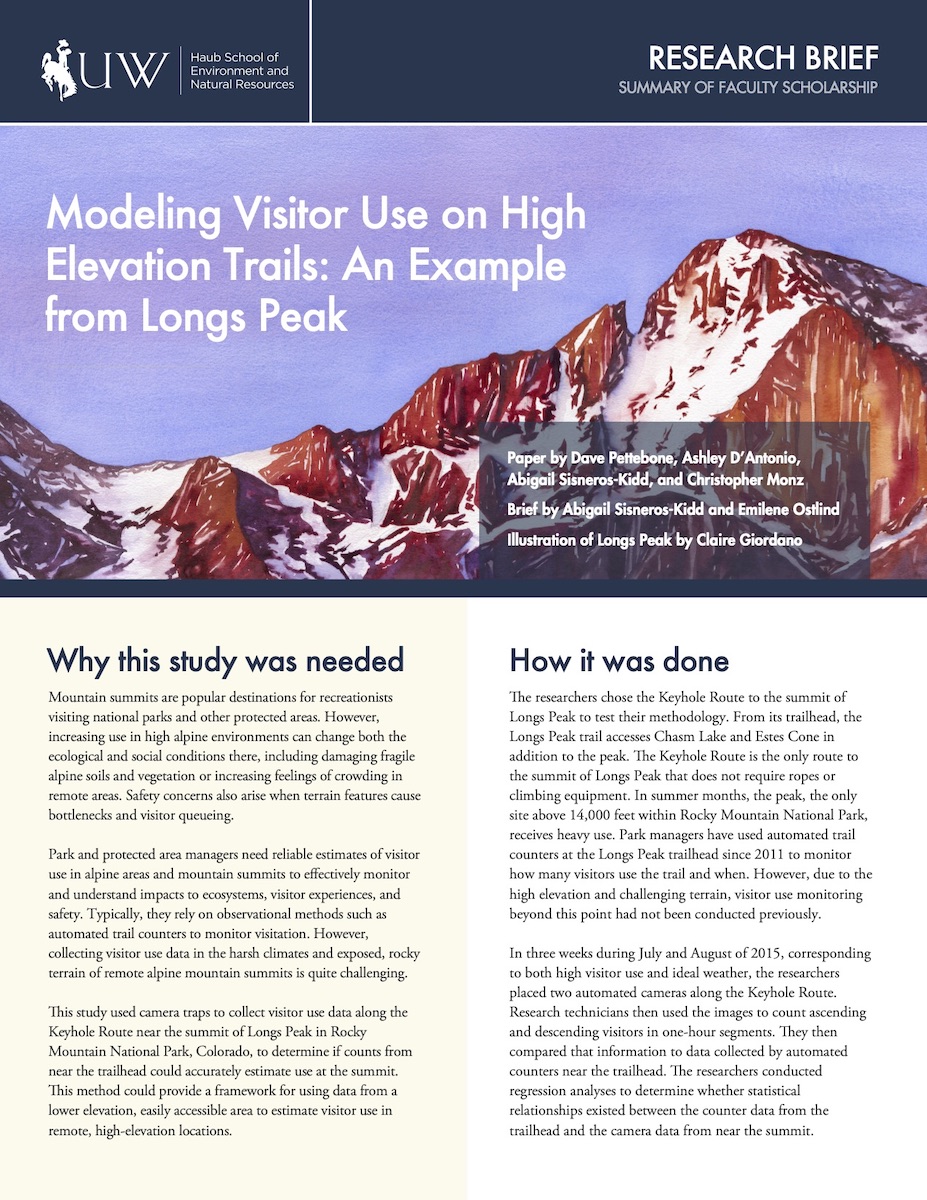 |
Modeling Visitor Use on High Elevation Trails: An Example from Long's PeakPaper by Dave Pettebone, Ashley D’Antonio, Abigail Sisneros-Kidd, and Christopher Monz This study used camera traps to collect visitor use data near the summit of Longs Peak in Rocky Mountain National Park, Colorado, to determine if counts from near the trailhead could accurately estimate use at the summit and to provide a framework for using data from a lower elevation, easily accessible area to estimate visitor use in remote, high-elevation locations. Explore the interactive version |
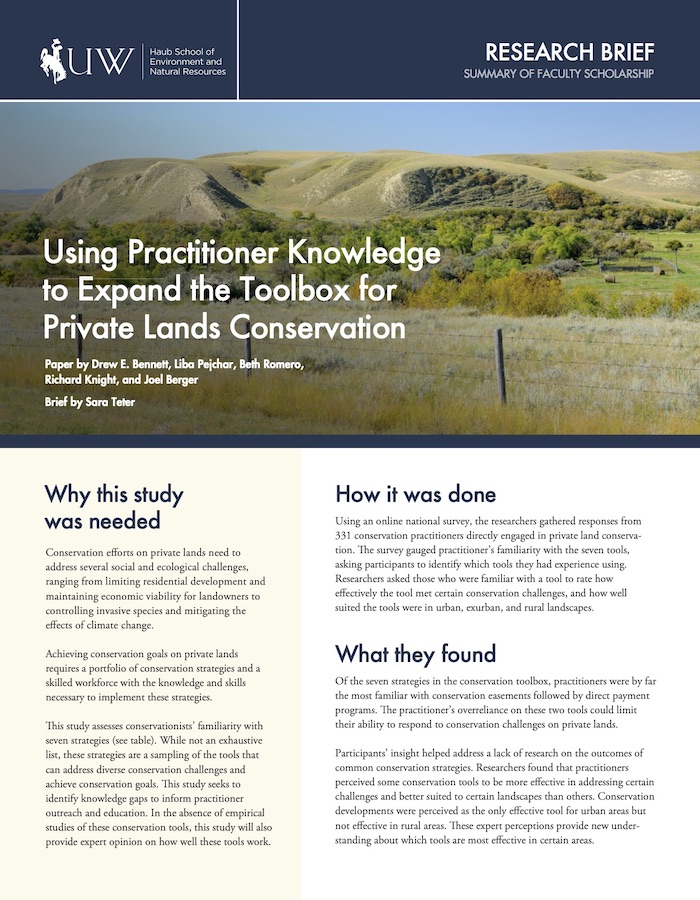 |
Using Practitioner Knowledge to Expand the Toolbox for Private Lands ConservationPaper by Drew E. Bennett, Liba Pejchar, Beth Romero, Richard Knight, and Joel Berger This study assesses familiarity with seven private land conservation strategies to identify knowledge gaps and provide expert opinion on how well these tools work. Explore the interactive version |
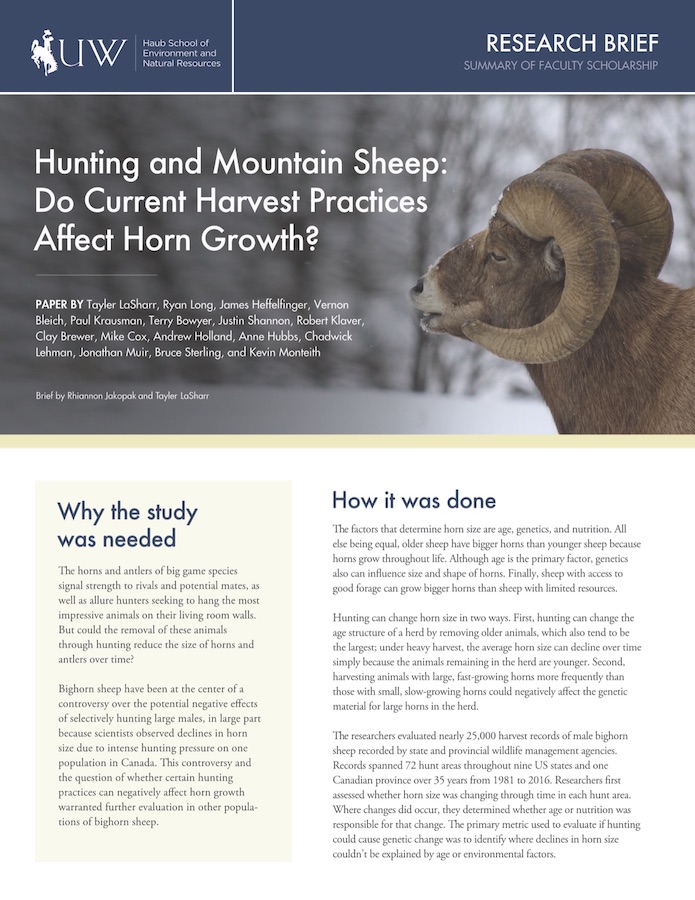 |
Hunting and Mountain Sheep: Do Current Harvest Practices Affect Horn Growth?Paper by Tayler N. LaSharr, Ryan A. Long, James R. Heffelfinger, Vernon C. Bleich, Paul R. Krausman, R. Terry Bowyer, Justin M. Shannon, Robert W. Klaver, Clay E. Brewer, Mike Cox, A. Andrew Holland, Anne Hubbs, Chadwick P. Lehman, Jonathan D. Muir, Bruce Sterling, and Kevin L. Monteith Horn size in a population of bighorn sheep in Canada declined due to intense hunting pressure. This raised the question of how current hunting practices might be affecting horns more broadly. Hunting can reduce mountain sheep horn size by removing older animals from a population and skewing the herd toward younger animals with smaller horns or by removing animals with genetic material for large horns from the herd. Researchers at the Haub School examined tens of thousands of harvest records of bighorn sheep from the western US and Canada to determine whether hunting pressure was causing genetic change in bighorn sheep herds. Explore the interactive version Read about this study in the Casper Star-Tribune |
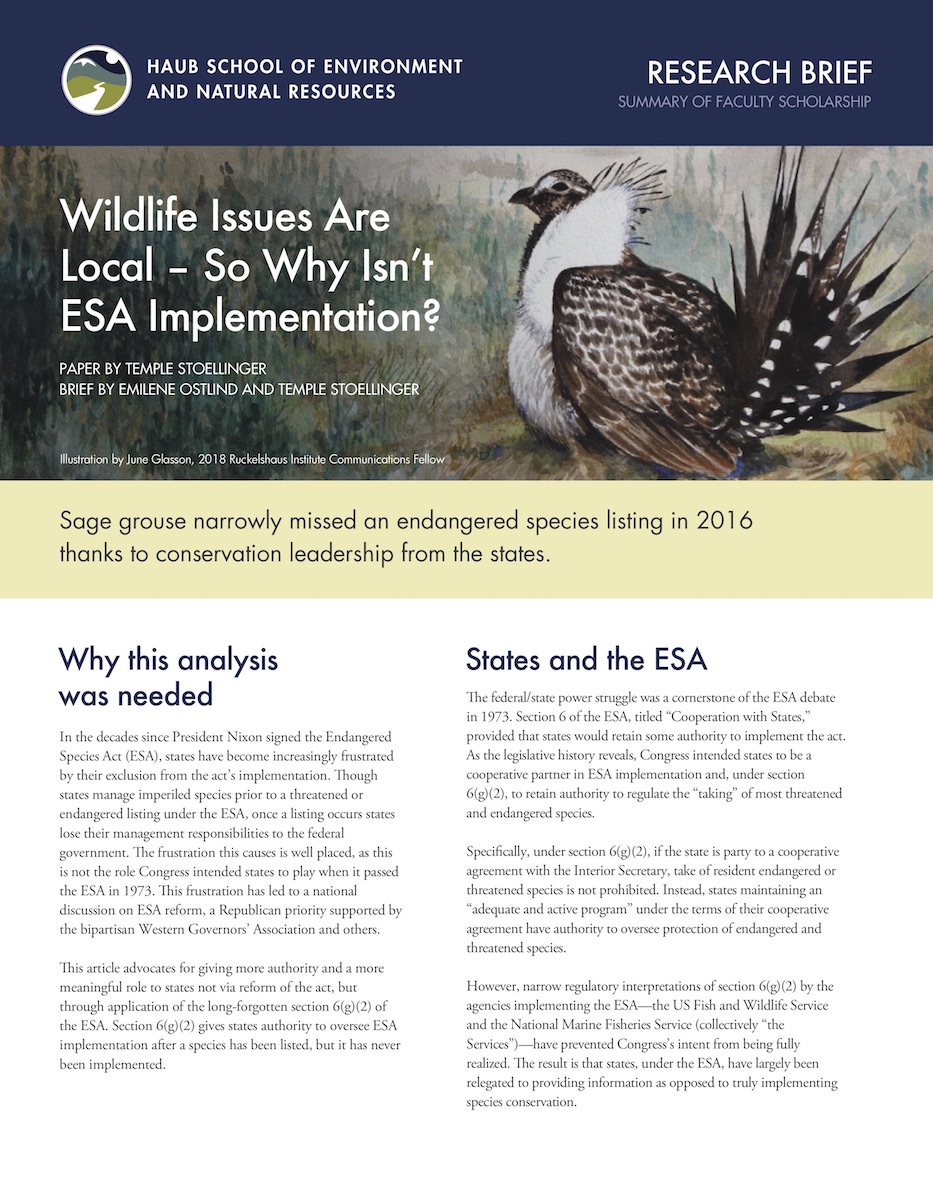 |
Wildlife Issues are Local – So Why Isn't ESA Implementation?Paper by Temple Stoellinger This research brief summarizes a legal analysis exploring the legislative history of the Endangered Species Act and making an argument for strengthening the role of states in conserving listed species. The study, by Haub School assistant professor and co-director for the Center for Law and Energy Resources in the Rockies, Temple Stoellinger, was published in UC Berkeley School of Law’s Ecology Law Quarterly. Explore the interactive version |
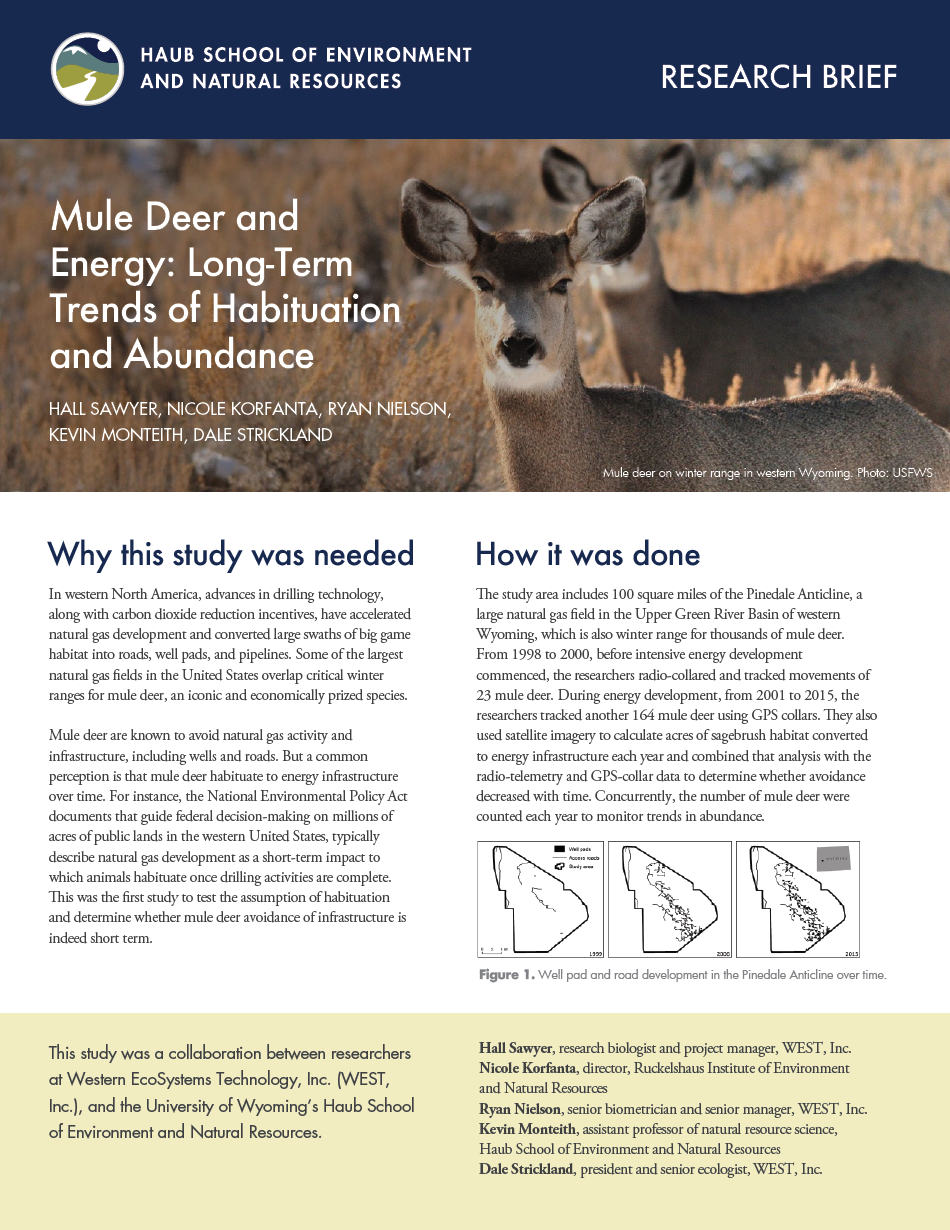 |
Mule Deer and Energy DevelopmentPaper by Hall Sawyer, Nicole Korfanta, Ryan Nielson, Kevin Monteith, and Dale Strickland This study investigated the long-term impacts of energy development on mule deer in the Upper Green River Basin of western Wyoming. The researchers used telemetry data from 184 deer across a 17-year period to determine whether deer habituated to energy development and if their response varied with winter severity. Explore the interactive version |

